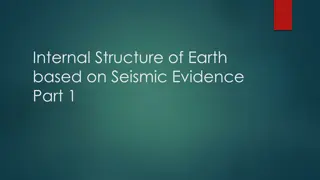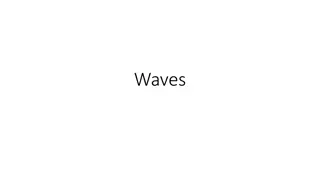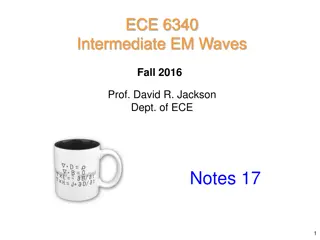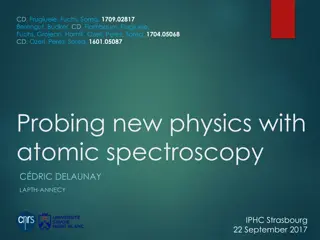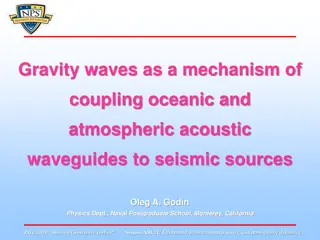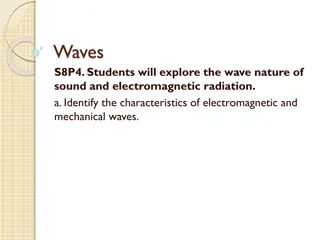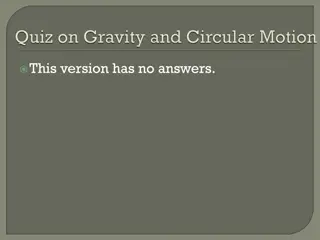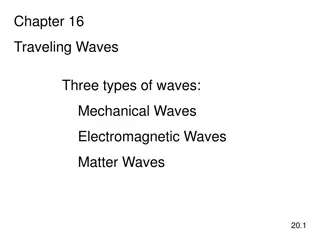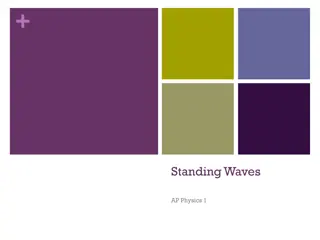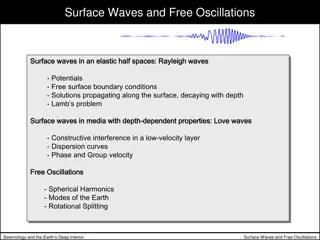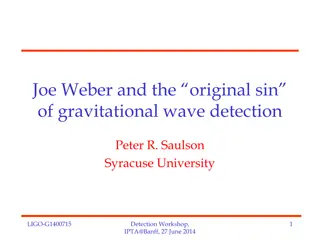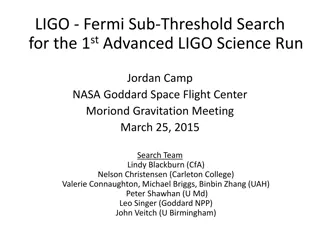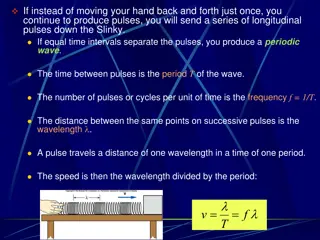Gravitational Waves: Probing Physics Beyond Standard Model
Investigate the novel probe of physics beyond the standard model using gravitational waves from the early universe. Explore principal sources such as inflation, preheating, and electroweak transition, providing insights into early universe dynamics. Discover how conformal symmetry breaking and other phenomena contribute to generating gravitational waves, offering a unique perspective on the cosmos.
Download Presentation

Please find below an Image/Link to download the presentation.
The content on the website is provided AS IS for your information and personal use only. It may not be sold, licensed, or shared on other websites without obtaining consent from the author.If you encounter any issues during the download, it is possible that the publisher has removed the file from their server.
You are allowed to download the files provided on this website for personal or commercial use, subject to the condition that they are used lawfully. All files are the property of their respective owners.
The content on the website is provided AS IS for your information and personal use only. It may not be sold, licensed, or shared on other websites without obtaining consent from the author.
E N D
Presentation Transcript
1 GRAVITATIONAL WAVES FROM THE EARLY UNIVERSE: A NOVEL PROBE OF THE PHYSICS BEYOND STANDARD MODEL Tomislav Prokopec, ITP, Utrecht University T. Prokopec, Jonas Rezacek and Bogumila Swiezewska , ``Gravitational waves from conformal symmetry breaking, JCAP (2019) to appear, arXiv:1809.11129 [hep-ph] T. Prokopec, Leonardo Chataignier da Rocha, Michael Schmidt, Bogumila Swiezewska, 1801.05258 [hep-ph], arXiv:1805.09292 [hep-ph] Stefano Lucat and T. Prokopec, arXiv:1705.00889 [gr-qc]; 1709.00330 [gr- qc];1606.02677 [hep-th] Alessandro Barnaveli, Stefano Lucat and T. Prokopec, arXiv:1809.10586 [gr-qc] JCAP (2019) Bergen, 07-02-2019
2 WHAT ARE THE PRINCIPAL SOURCES OF GRAVITATIONAL WAVES IN THE EARLY UNIVERSE?
3 SOURCES
4 PRINCIPAL SOURCES: INFLATION 1) GRAVITATIONAL WAVES VIOLATE WEYL (CONFROMAL) SYMMETRY, THEREFORE COUPLING TO UNIVERSE s EXPANSION GENERATES GWs: ???= ?2(?) ???+ ??(?) ?2 ?? ??2+ 2? ? 2 ?? ?2 ? ?? ?? = 0 - TODAY the Hubble rate H is exceedingly small, so this effect is tiny. - HOWEVER, in the early Universe, H was large, so this effect was LARGE - fluctuations of gravitational waves, resulting in a spectrum: ??,?? = ?2?? During COSMIC INFLATION, it lead to amplification of the vacuum 2? 2 ? ? ? ? 2 2, ??= 2? , ? = ??= ?? Starobinsky (1979) Since ??< 0, the spectrum is red, hence typically unobservable by LISA. - Possibly observable by the next generation of dedicated CMB experiments. -
5 PRINCIPAL SOURCES: PREHEATING AFTER INFLATION A LOT OF (INFLATON FIELD) ENERGY IS DUMPED INTO (NON-)STANDARD MODEL FIELDS. THEY SOURCE GWs via: ????=8 ?? ?4???? - Typically, the frequency is too high, to be observable by today s and planned GW observatories: ?~108?? OTHER SOURCES INCLUDE: Decay of heavy particles during radiation era (typically too weak signal). Decay of cosmic string networks and other topological defects) - - (weak signal, but long lasting source, thus potentially observable) - Decay of PBHs - the most promising being the electroweak phase transition First order phase transitions,
6 ELECTROWEAK TRANSITION - PROMISING: FREQUENCY ALMOST IN THE SWEET SPOT OF LISA ?0~10 17?? @ ?0= 2.7 ?~3 10 13GeV 2 ???~102GeV & ???~3 1014, ???~??? ??~10 13GeV ?~109?? - LEADING TO TODAY s FREQUENCY: ??? ???~10 5Hz ?0= A MORE CAREFUL ANALYSIS LEADS TO
7 SENSITIVITY CURVES NB: ET: max sensitivity at frequencies slightly above LIGO/VIRGO
8 CONFORMAL EXTENSIONS OF SM
9 Already in Caprini, Hindmarsh et al 1512.06239 it was pointed out that due to the flat nature of the effective potential, one expects strongly first order EW phase transition, a large supercooling and a large GW production. In arXiv:1809.11129 [hep-ph] [T. Prokopec, Jonas Rezacek and Bogumila Swiezewska, ``Gravitational waves from conformal symmetry breaking, JCAP (2019)] WE STUDIED A SIMPLE WEYL SYMMETRIC (CONFORMAL) EXTENSION OF THE STANDARD MODEL, SU(2)cSM, AND SHOWED THAT THE PROPOSITION OF CAPRINI AND HINDMARSH WAS CORRECT. APART FROM STANDARD MODEL SPECIES, THE MODEL CONTAINS - PORTAL SCALAR CHARGED UNDER AN HIDDEN SU(2)_X - PORTAL GAUGE FIELD CHARGED UNDER N HIDDEN SU(2)_X - WHEN COMPARED WITH SM, SU(2)cSM has 2 ADDITIONAL PARAMETERS: SU(2)_X gauge coupling and 2 scalar couplings, but has no Higgs mass - THE MODEL IS PERTURBATIVE UP TO THE Planck SCALE - THE SU(2)_X GAUGE FIELD CAN BE DARK MATTER
10 SU(2)cSM PRODUCES GENERICALLY A STRONG GW SIGNAL BECAUSE THE EFFECTIVE 0-TEMPERATURE POTENTIAL IS FLAT AROUND THE ORIGIN!
11 RADIATIVE SYMMETRY BREAKING IN SU(2)cSM TREE POTENTIAL EFFECTIVE POTENTIAL
12 THE FINITE T EFFECTIVE POTENTIAL - TO CONSTRUCT IT, WE USED A GAP EQUATION. NEEDS IMPROVEMENT IN THE GAUGE SECTOR.
13 PHASE TRANSITION: 2 SCALAR FIELDS
14 LISA SENSITIVITY CURVES
15 GRAVITATIONAL WAVE SPECTRUM ? 4 ?3 BENCHMARK POINTS
16 ANALYTICS: POWER & FREQUENCY
17 DETECTING TORSION WAVES
18 GRAVITATIONAL WAVES GRAVITATIONAL WAVES
18 DETECTORS FOR TORSION WAVES GW INTEFEROMETERS such as aLIGO/VIRGO TORSION TRACE LONGITUDINAL DETECTOR RESPONSE TRANSVERSE DETECTOR RESPONSE GRAVITATIONAL WAVES vs TORSION WAVES: a comparsion PHASE SHIFT PERIOD FREQUENCY DEPENDENCE TORSION TRACE (L) COUPLES TO TRACE OF STRESS-ENERGY TENSOR
20 TORSION SOURCES E.G.: TORSION TRACE: LONGITUDINAL MODE ITS MASS IS PROTECTED BY THE CONFORMAL WARD-TAKAHASHI, THIS IMPLIES ABOUT 1 order of magnitude suppression when compared with the amplitude of gravitational waves, i.e. ?? 2 ~?2 e=sources excentricity (can be as large as ~0.5) DETECTABLE BY THE NEXT GENERATION OF OBSERVATORIES such as EINSTEIN TELESCOPE.
21 CONCLUSIONS AND OUTLOOK
22 CONCLUSIONS AND OUTLOOK CHALLENGES FOR THE 2030s: MAKE QUANTITATIVELY RELIABLE PREDICTIONS OF THE GRAVITATIONAL WAVE SPECTRUM FROM DIFFERENT (WEYL SYMMETRIC OR NOT) EXTENSIONS OF THE STANDARD MODEL. - better understand the dynamics of the EW PT (expertise in NL) UNDERSTAND HOW TO RELATE FUNDAMENTAL PARAMETERS OF THE MODEL TO THE OBSERVED SPECTRUM. - today, this understanding is at best rudimentary UNDERSTAND BETTER HOW TO DETECT DEVIATIONS FROM GR, IN PARTICULAR THOSE OF WEYL SYMMETRIC EXTENSIONS OF GR. (AN IMPORTANT EXAMPLE IS DETECTION OF SPACETIME TORSION BY GRAVITATIONAL WAVE EXPERIMENTS.) - Such extensions are theoretically particularly attractive, as they can be used to severly constrain models of gravity coupled to matter. Furthermore, theoretical understanding of these models at high energies may be analytically tractable.
22 SU(2)cSM NO HIGGS MASS TERM, BUT ADITIONAL TERMS IN THE PORTAL LAGRANGIAN: +?? 1 ??= ?? 2?2 ? 4 ?? 4?? ?????? & ??IN FUNDAMENTAL AND ADJOINT REPRESENTATION OF ??(2)? ?? = ?? +? 2 ??? = ???? ????+ ???[????], 2?? + ????? SIMPLEST MODEL: PERT AT PLANCK SCALE AND EXHIBITS CW MECH MANY OTHER VARIANTS POSSIBLE: ??(?)? + HIDDEN FERMIONS


